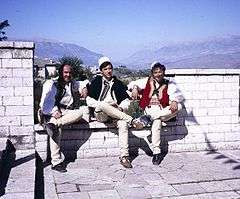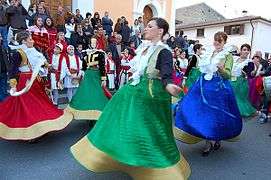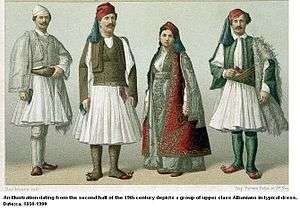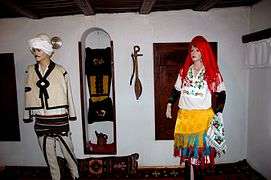Albanian national clothing
The traditional clothing of Albania (Albanian: Veshjet Tradicionale Shqiptare; Veshjet Kombëtare; Veshjet Popullore or Kostumet Kombëtare) includes more than 200 different varieties of clothing in all Albania and the Albanian-speaking territories and communities (including the Arbëreshë in Italy, Arvanites in Greece and Arbanasi in Croatia). Albania's recorded history of clothing goes back to classical times.[1] It is one of the factors that has differentiated this nation from other European countries, dating back to the Illyrian period.
| Part of a series on the |
| Culture of Albania |
|---|
 |
|
|
People
|
|
|
|
Mythology and folklore
|
|
Festivals
|
|
Music and performing arts |
|
Media |
|
Sport
|
|
Monuments |
|
Almost every cultural and geographical region in Albania has its own specific variety of costume that varies in detail, material, color, shape, and form. Albanian folk dress is often decorated with symbolic elements of Illyrian antique pagan origin, like suns, eagles, moons, stars, and snakes.[2] Fabrics are traditionally made by weaving clothes using looms. To this day, some conservative old men and women mainly from the North wear traditional clothing in their daily lives. Instead, older women from the South usually wear all-black outfits.
Parts
Albanian dress consists of the following
Headgear
Men
The following headdresses are in use for men:
- Qeleshe [cɛˈlɛʃɛ] or plis: a type of hat worn by men in Albania, Kosovo, and the Albanian-speaking parts of Greece and North Macedonia. This type of hat was copied by ancient Greek 'liberty' cap called pileus, not only in shape, but obviously in etymology too (,Albanian - 'plis' Ancient Greek 'pilos'). In central Albania (Tirana, Durrës, Kavaja) it is cone-shaped, and in North Albania and Kosovo round.
- Albanian hat (French: Chapeau albanois)[3] worn typically during the 15th to 18th centuries[4] and immortalized in Onufri's paintings.
- Qylafë [ˈcylaf]: a woolen high hat worn in southern Albania.[5]
Women
The following headdresses are in use for women:
- Kapica [kaˈpitsa]: a headdress for women.
- Langi, other names include: peshqira, riza, marhamë, pashnik.
- Lëvere [ləˈvɛɾɛ]: right shaped headdress.
- Kryqe [ˈkɾycɛ]: square shaped headdress.[6]
Pants and upper body covers
- Fustanella [fustaˈnɛɫa]: traditional skirt-like garment worn by men.
- Tirq[7] [tiɾc]: long pants worn by men.
- Brekusha [8][bɾɛˈkuʃa]: for men and women.
- Xhubleta [dʒuˈblɛta]: Only worn by women.
- Mbështjellëse[9]- Only worn by women.
Xhamadan
A xhamadan is a traditional vest, which is worn by Albanian men throughout Albania, in Kosovo, North Macedonia, Serbia, Montenegro, and in the Arbëresh villages in Italy.
Brez
Brez are traditional belts, which are worn by Albanian men throughout Albania, in Kosovo, North Macedonia, Serbia, Montenegro, and in the Arbëresh villages in Italy.
Çorape
Çorape are traditional socks which are worn by Albanian men throughout Albania, in Kosovo, North Macedonia, Serbia, Montenegro, and in the Arbëresh villages in Italy.
Opinga
Opinga Albanian pronunciation: [ɔˈpiŋɡa]: (Art sandals), are traditional shoes which are worn by Albanian men throughout Albania, in Kosovo, North Macedonia, Serbia, Montenegro, and in the Arbëresh villages in Italy.
Gallery
 Albanian folk singers
Albanian folk singers.jpg) Central Albanian women's dresses
Central Albanian women's dresses- Woman's sleeveless jacket
_(CS)%2C_Le_Vallje_2009._(5).jpg)

- Costumes from Dibra
 Fustanella
Fustanella Albanians in Greece
Albanians in Greece Albanian in Egypt
Albanian in Egypt Traditional clothing
Traditional clothing- Albanian clothing from Kosovo
- From Kosovo
- From Kosovo
See also
References
- "Albania", Encyclopedia of National Dress: Traditional Clothing Around the World, ABC-CLIO, 2013, p. 16, ISBN 9780313376368
- Leyla Belkaid (2013), "Albania", in Jill Condra (ed.), Encyclopedia of National Dress: Traditional Clothing Around the World, I, ABC-CLIO, p. 16, ISBN 9780313376368
- de La Curne de Sainte-Palaye, Jean-Baptiste (1875). Dictionnaire historique de l'ancien langage françois (in French). Champion (T. 01-09). pp. 316–.
- Anamali, Skënder (2002). Historia e popullit shqiptar në katër vëllime (in Albanian). I. Botimet Toena. p. 300. OCLC 52411919.
- Gjergji 2004: S. 191
- Gjergji 2004: S. 194
- "tirk - Wiktionary". en.wiktionary.org. Retrieved 19 July 2017.
- "Traditional Albanian clothing - Nationalclothing.org". forum.nationalclothing.org. Retrieved 19 July 2017.
- "dict.cc dictionary :: mbështjellëse :: English-Albanian translation". browse.dict.cc. Retrieved 19 July 2017.
Further reading
- Andromaqi, Gjergj (2004). Albanian Costumes Through the Centuries: Origin, Types, Evolution. Mësonjëtorja. ISBN 978-99943-614-4-1.
- Andromaqi, Gjerjgi (1999). Albanian Folk Costumes. Instituti i Kulturës Popullore, Departamenti Etnologjisë. ISBN 978-99927-654-6-3.
External links
| Wikimedia Commons has media related to Traditional Albanian clothing. |




